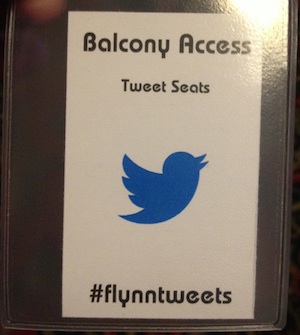This weekend I was part of an experiment conducted at the
Flynn Center for the Performing Arts. Marketing Director Leigh Chandler invited
a group of local "Tweeters" to attend a concert in order to share live
reactions through social media. Using the hashtag #FlynnTweets, we sat in the
first row of the otherwise closed off balcony and watched a show with
guitarists David Hidalgo and Marc Ribot.

As I walked into the theater, I met a colleague of mine. Her
husband was one of the sponsors. The first thing he said to me was that he
hoped we weren't going to disturb the performance.
I can understand that. No one wants to pay money to see a
concert only to have someone in the next seat tapping into their (bright) smart
phone and giggling when reading responses. That did happen up in the Tweet
seats. But since we were far away from the paying guests, no one seemed to
mind.
Watching and tweeting simultaneously is a tough balancing
act. It's a common challenge even at social media conferences, where people
spend more time tweeting out key quotes from speakers than they do sitting
back, listening and reflecting. It was an issue at the Flynn as well; several
Tweeters lamented that they felt "split" between trying to enjoy the concert
and providing social commentary.
Another challenge is that we who tweet love to see what kind
of response we get. After all, that is the whole idea of "social" media; not
just broadcast but response and conversation. It was a little too tempting to
check your smart phone to see who responded or retweeted you. More often than
not, it was the person sitting next to you in the balcony. So there was this
strange but fun conversation happening between us as almost a secret layer to
the concert.
The tweets, though, did get great feedback outside of the
building. A number of people on Facebook or Twitter responded that they wished
they were there at the concert. It certainly spread the word about Hidalgo and
Ribot to people who might not have known who they were. It definitely got good
PR play in the local media (it helped that the major newspaper had a person in
the Tweet seats).

Will it have a long lasting effect, or will it be
sustainable? According to Leigh Chandler, she wants to do this again. She
certainly pulled together a fun group of people for the inaugural event. I'm
sure there are others who would love to have a great, free seat in exchange for
tweeting.
Will it sell tickets? Well, that's the real question. It's
not feasible to do this for a sold out concert, nor does the Flynn need to. I
wonder, though, if it's possible to always have a few Tweet Seats way in the
back, so they don't disturb anyone.
One idea might be to not focus so much on the
concert or event itself, but to reward people who've already purchased tickets
backstage access before and after a concert so that they can tweet and post
pictures. That would be a great, social reward to paying and loyal customers.
It's certainly something tweeters and others would brag about on social media.
The content from those interactions could provide a sustainable fodder for
Flynn's ongoing marketing.
What the Flynn Center really did during #FlynnTweets was to
firm up its position as a very innovative organization in Burlington and to
firm up established relationships with key influencers. Whether the tweets
themselves provided great value might not be the point. I would love to see them
continue to integrate social into their core business beyond the occasional social
event.
I hope that's the case, mostly because I love what they do,
in our community and in our schools.
